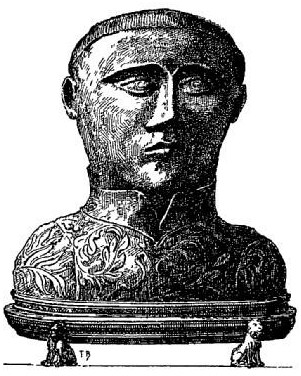
Piran or Pyran, died c. 480, was a 5th-century Cornish abbot and saint, possibly of Irish origin. He is the patron saint of tin-miners, and is also generally regarded as the patron saint of Cornwall, although Michael and Petroc also have some claim to this title.

Petroc or Petrock was a British prince and Christian saint.
Breage or Breaca is a saint venerated in Cornwall and South West England. According to her late hagiography, she was an Irish nun of the 5th or 6th century who founded a church in Cornwall. The village and civil parish of Breage in Cornwall are named after her, and the local Breage Parish Church is dedicated to her. She is a saint in the Eastern Orthodox Church and Catholic Church.
Saint Carthage the Elder was an Irish bishop and abbot in the sixth century. His feast day is 5 March.

Saint Ciarán of Clonmacnoise, supposedly born Ciarán mac an tSaeir, was one of the Twelve Apostles of Ireland and the first abbot of Clonmacnoise. He is sometimes called Ciarán the Younger to distinguish him from the 5th-century Saint Ciarán the Elder who was bishop of Osraige. His name produced many variant spellings, including Ceran, Kieran, Queran and Queranus.

August 3 - Eastern Orthodox liturgical calendar - August 5
Senán mac Geircinn was an Irish Christian minister. He was a resident of Munster and is important in Irish tradition, as founder of Inis Cathaigh and patron of the Corco Baiscinn and the Uí Fhidgeinte. He is listed among the Twelve Apostles of Ireland.

March 4 - Eastern Orthodox liturgical calendar - March 6
Kea was a late 5th-century British saint from the Hen Ogledd —the Brythonic-speaking parts of what is now southern Scotland and northern England. According to tradition he was chiefly active in Cornwall, Devon and Brittany, and his cult was popular in those regions as well as throughout Wales and the West Country. Fili or Filius, to whom the parish church of Philleigh is dedicated, probably came from Wales and is said to have been a companion of Kea.

Sithney is a village and civil parish in the West of Cornwall, England, United Kingdom. Sithney is north of Porthleven. The population including Boscadjack and Crowntown at the 2011 census was 841.

Winwaloe was the founder and first abbot of Landévennec Abbey, also known as the Monastery of Winwaloe. It was just south of Brest in Brittany, now part of France.
Gilbert Hunter Doble was an Anglican priest and Cornish historian and hagiographer.

Ciarán of Saigir, also known as Ciarán mac Luaigne or Saint Kieran, was one of the Twelve Apostles of Ireland and is considered the first saint to have been born in Ireland, although the legend that he preceded Saint Patrick is questionable. Ciarán was bishop of Saighir (Seir-Kieran) and remains the patron saint of its successor, the diocese of Ossory.

Melor was a 10th-century Breton saint who, in England, was venerated in Cornwall and at Amesbury Abbey, Wiltshire, which claimed some of his relics.

Budoc of Dol was a 5th-century Breton monk and Bishop of Dol, who has been venerated since his death as a saint in both Brittany and Devon. Budoc is the patron saint of Plourin in Finistère where his relics are preserved. His feast day was originally celebrated on 8 December, the date still used in Devon, but in Brittany this has been transferred to 9 December.
Elwen was the name of an early saint or saints venerated in Cornwall and Brittany. The hagiographical material asserts that he came to Cornwall from Ireland in the company of Breage and six others, but this is attested late. A chapel at Porthleven in Sithney parish, Cornwall, dedicated to Elwen, existed from the 13th century until 1549, and in Brittany several sites and placenames are associated with possibly related figures.

Maudez is a Breton saint who lived in the 5th or 6th century. He is also known as Maudé, Maudet, Maodez or Modez (Breton), Maudetus (Latin), Mandé (French) and Mawes. In the Breton calendar his feast is 18 November.
Saint Senara, also known as Asenora, Sinara, or Sennara, is a legendary Cornish saint with links to the village of Zennor on the north coast of Cornwall, UK. The Church of Saint Senara, Zennor is dedicated to her, and according to legend her name inspired the name of the village of Zennor along with local features like Zennor Head and Zennor Quoit.
Rumon of Tavistock is a saint venerated in the traditions of the Catholic, Anglican Communion, and Western Orthodox churches.










